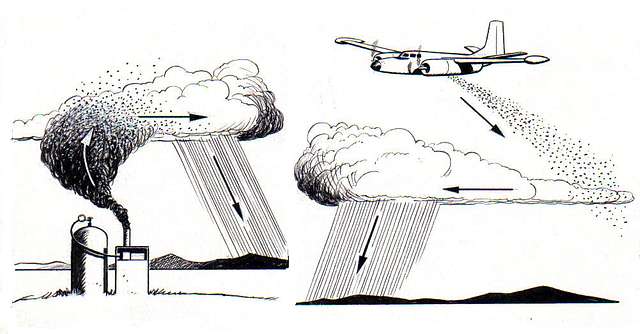Cloud seeding :
When it comes to meteorology, cloud seeding is a fascinating and controversial method that has scientists, decision-makers, and environmentalists all talking. The application and consequences of this technology, which aims to manipulate cloud precipitation processes, are complex and promising.
Cloud Seeding’s Mechanisms:
Rearranging the microphysics of the cloud to induce precipitation is the basis for cloud seeding. To enhance rainfall or snowfall, particles of dry ice, potassium iodide, or silver iodide are frequently added to clouds to act as nuclei around which droplets of water can form. Aircraft or ground-based generators are used to carefully target clouds in order to induce precipitation when delivering these seeding materials.

Uses and Possible Advantages:
There are several possible uses for cloud seeding. Its main purpose is to provide a way to deal with the problem of water scarcity, particularly in dry areas or during dry spells. Cloud seeding has the potential to support water resources that are essential for domestic, industrial, and agricultural usage by increasing precipitation. Furthermore, it is regarded as a method to lessen the effects of hailstorms by changing the formations of clouds, safeguarding houses and crops.
Moreover, cloud seeding may contribute to higher snowpack levels in areas that depend on snowfall for water supply, including mountainous regions, which could affect downstream water availability in the spring and summer.
Debates pertaining to cloud seeding:
Even with its promise, cloud seeding remains a contentious and unclear topic:
Validity from a scientific standpoint: There is ongoing discussion on the effectiveness of cloud seeding. Although certain research indicates a rise in precipitation as a result of seeding, it is difficult to precisely quantify its influence in the context of intricate weather patterns, which results in differing opinions regarding its efficacy.
Environmental Concerns: There are good reasons for critics to be concerned about how adding foreign compounds to the atmosphere may affect the environment. Concerns include possible unforeseen outcomes, air quality, and long-term effects on ecosystems.
Implications for Society and Ethics: Weather modification techniques raise important ethical questions. The topics of discussion include the rights of areas to control natural processes, possible conflicts resulting from interventions, and the moral obligation related to changing weather patterns.
Regulatory Obstacles: One of the biggest obstacles is the lack of international agreements and thorough laws governing weather modification activities. Determining legal obligations and duties in the event of unfavorable outcomes or disagreements between nations involved in cloud seeding operations is still an open question.
Prospects for Future Research and Directions:
Ongoing study in cloud seeding is driven by technological advancements and a growing comprehension of atmospheric processes. Researchers are experimenting with novel approaches, such as using drones to plant crops precisely, improving seeding mixes, and using advanced modeling tools to more accurately forecast the results of these treatments.
In conclusion:
Cloud seeding is still a technology fraught with ethical questions and difficulties, despite its potential to manage weather patterns and alleviate water scarcity. In light of the challenges posed by a changing climate, society must prioritize responsible inquiry and application in conjunction with thorough scientific review.
As discussions go on, it is still critical to adopt a balanced strategy that balances possible advantages with ethical, scientific, and environmental considerations. As we navigate its intricacies, cloud seeding demands careful study since it sits at the nexus of science, policy, ethics, and environmental stewardship.
Read more about Technology and trending topics at :https://dailytrendspot.com/
